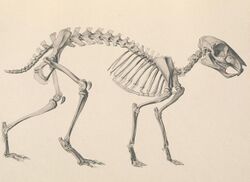Biology:Eocardiidae
| Eocardiidae | |
|---|---|

| |
| Skeletal restoration of Eocardia | |
| Scientific classification | |
| Domain: | Eukaryota |
| Kingdom: | Animalia |
| Phylum: | Chordata |
| Class: | Mammalia |
| Order: | Rodentia |
| Superfamily: | Cavioidea |
| Family: | †Eocardiidae Ameghino 1891 |
| Subfamilies and genera | |
|
†Eocardiinae
†Luantinae
| |
The Eocardiidae are an extinct family of caviomorph rodents from South America. The family is probably ancestral to the living family Caviidae,[1] which includes cavies, maras, and capybaras and their relatives. McKenna and Bell (1997) divided eocardiids into two subfamilies, Luantinae for two of the oldest genera (Asteromys and Luantus) and Eocardiinae for remaining genera. Kramarz (2006) has recommended the abandonment of these subfamilies, as the genera placed in Luantinae appear to represent basal eocardiids, rather than a specialized side branch. The latter hypothesis had been proposed by Wood and Patterson (1959).[2]
Fossils of the family were found in the Colhuehuapian to Friasian Pinturas, Sarmiento, Santa Cruz, Río Jeinemeiní and Collón Curá Formations of Argentina and the Cura-Mallín Group of Chile.[3]
References
- ↑ Kramarz, 2006
- ↑ Wood & Patterson, 1959
- ↑ Eocardiidae at Fossilworks.org
Bibliography
- Kramarz, Alejandro G. (2006). "Eocardiids (Rodentia, Hystricognathi) from the Pinturas Formation, late early Miocene of Patagonia, Argentina". Journal of Vertebrate Paleontology 26 (3): 770–778. doi:10.1671/0272-4634(2006)26[770:erhftp2.0.co;2].
- Wood, A.E. and Patterson, B. 1959. Rodents of the Deseadan Oligocene of Patagonia and the beginnings of South American rodent evolution. Bulletin of the Museum of Comparative Zoology 120:281-428.
Further reading
- McKenna, Malcolm C., and Bell, Susan K. 1997. Classification of Mammals Above the Species Level. Columbia University Press, New York, 631 pp. ISBN:0-231-11013-8
Wikidata ☰ Q5381604 entry
 |

